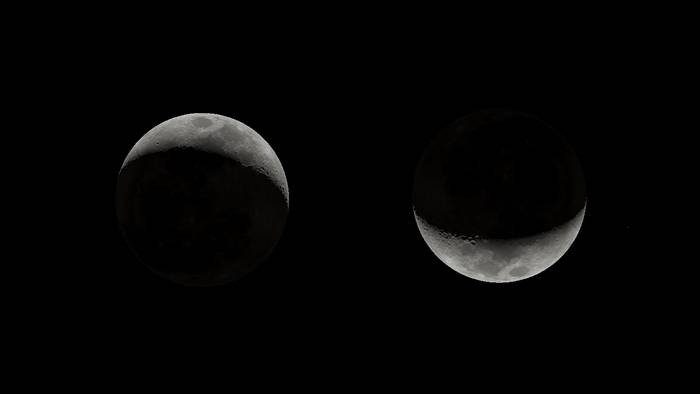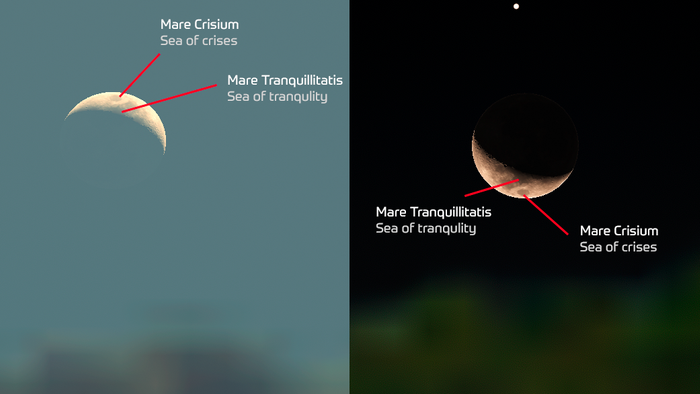
What does the Moon look like at the equator?
If you’ve seen books about astronomy, you may have come with a passage similar to this: The Moon looks upside down in the southern hemisphere compared to the northern one. But what about the equator? Clearly there must be something in between if it’s in the middle of the two hemispheres, right?
But if you search for this question on the Internet, you won’t find much detailed information about it. So I decided to provide a detailed explanation as to what it looks like and why.
Just a disclaimer: I don’t want to run into hot debates about the shape of the Earth, so I’ll just say that this takes into consideration the nearly universally accepted round model in which the Earth is a sphere.

To lay the groundwork, many people are aware of the phases of the Moon, which are caused by how the half of the Moon lit by the Sun changes as it orbits the Earth. If one were in space above the orbital plane of the Earth while its northern hemisphere faces up, the Moon would look as if it were to be orbiting the Earth in a counter-clockwise motion.
Because of this, the waxing crescent and its following quarter (the 1st), in the northern hemisphere will look like the letter D, while in the southern hemisphere it will look like a letter C. If the orbit were to be clockwise, it would be the other way around.
In Spanish there is a really interesting mnemonic for this:
- In the northern hemisphere, the Moon is a liar. This is because the 1st quarter is called cuarto creciente (quarter increasing in size to full moon), but it will have a D shape. When it has a C shape, it’s called cuarto decreciente (quarter decreasing in size to new moon).
- In the southern hemisphere, the Moon always tells the truth, because an upside down cuarto creciente looks like a C, and an upside down cuarto decreciente looks like a D.
Since the Moon is just rotating 180° when we change hemispheres, it’s safe to assume that in the equator it’d make a 90° turn, right?
But that rises the question: Which way? It could be a clockwise rotation, in which case a waxing crescent would look like a smile; or a counter-clockwise one, where it would look like a frown. So which one is it?
The short answer is… Both! It depends on when you’re looking at the waxing crescent Moon while it moves across the sky. At moonrise, it looks like a frown. At moonset, it looks like a smile.

The long answer doesn’t require understanding orbital dynamics or any other kind of complicated physics: It’s just geometry.

Why? Because the Earth rotates counter-clockwise around a stable axis, from west to east. The axis does drift, but this motion is so slow and tiny that it doesn’t have much of an effect in our day to day lives —it’d take hundreds to thousands of years for it to have made a significant change.
From Earth, we see objects in the sky rising from the east and setting at the west, making a clockwise motion as they scour it. The reason the direction of movement is the opposite is because when moving alongside the Earth’s surface, from our perspective the surface remains static, while the sky moves. A bit like when riding a car, bus or train and the background outside the vehicle seems to be moving backward, while it’s the vehicle that moves forward.
If one were to be constantly looking at the Moon from the equator as it moved towards the sky (for clearance’s sake, let’s call this Earth observer), at one point it’d make a sharp 180° turn once it passes above the Earth observer’s head. This is because from someone outside the Earth’s perspective (let’s call them the space observer), the Earth observer would’ve flown past the Moon, and unless they’d have impressive limbo skills, the Earth observer would have to turn around to continue seeing the moon, flipping the picture as a result.

This effect remains visible in places away from the equator, but it’s more of a gradual change and not a very sharp turn. This is because at the equator, the Moon will pass by really close to the zenith —the point in the sky directly above an Earth observer’s head— but as you go closer to one of the Earth’s poles, the Moon won’t reach as high in the sky since you’d be looking at it at an angle and not directly perpendicular to the ground, and it will go past your head at a slower pace.
Plus, the Moon will drift slightly towards the north or south, depending on the latitude and the phase it’s currently at. Calculating how far did the Moon and Sun rise from the horizon at a given time of the year is how people used to figure out the latitude they were at before GPS was a thing!

Add the fact that near the poles the axis of rotation of the Earth will get closer to the zenith, so things closer to the horizon will hardly experience any rotation; and you get an explanation of why the Moon hardly rotates as you move further away from the equator.
But as I was researching this, another question surfaced my mind: How does the Moon rotate as you get closer to the equator? If one were to look at the orientations of the Moon from different latitudes, one would assume that it’d be rotating counter clockwise as the latitude decreases, and clockwise as it increases. But this is not completely correct.
The actual answer is a bit more complicated. Essentially, when we move strictly south or north, the entire celestial sphere will rotate in the East-West axis. Looking directly eastward, the sky will appear to rotate counter-clockwise, and clockwise if you look to the west. But the cardinal directions are points on the Earth’s surface, not the sky. This means that as the Earth rotates, the cardinal directions will remain in the same place, while anything in the celestial sphere —like the Moon— will move from east to west. When the Moon is close to the East, it will rotate counter-clockwise as latitude decreases, and clockwise as it increases, as stated above. But if it’s on the West, this motion is flipped.
If you were to change your latitude and eventually cross one of the poles, your longitude would rotate 180°, switching the opposing cardinal directions. Once you cross the pole you can further increase or decrease your latitude and move the sky in the same axis of rotation, but what was on the west is now on the east, essentially flipping the way they rotate.
All of this “it’s the opposite, actually” being repeated over and over again might confuse you quite a bit, so I recommend simulating how the Moon changes in Stellarium whilst changing the latitude. But ultimately, all of these motion dynamics work in unison so that no matter where in the equator and at which day of the year you look at, the waxing crescent moon looks like a frown at moonrise, and a smile at moonset, and the opposite when it’s a waning crescent.


